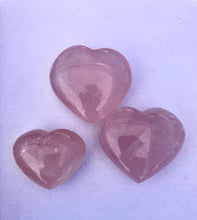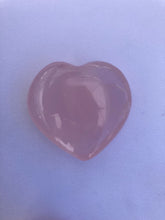Polished Rose Quartz Hearts - Medium Small
Average Weight: 0.8 lb / 0.4 kg
Origin: Madagascar
Rose Quartz the name used for pink specimens of the mineral quartz. It is usually occurs as massive, anhedral occurrences in hydrothermal veins and pegmatites.
The pink color of Rose Quartz is attributed to microscopic inclusions of a pink variety of the mineral Dumortierite. These inclusions are usually abundant enough to make the Rose Quartz translucent instead of transparent. Rarely, quartz occurs as transparent euhedral crystals with a pink color. These are usually late-stage mineralizations in pegmatite pockets. The color of these specimens, especially those that are transparent, is thought to be caused by irradiation-induced color centers. This color is often unstable, fading with exposure to heat or light. Pink transparent quartz is rare, but found in several locations around the world.
Some specimens of Rose Quartz contain a dense network of fine inclusions that align with the gem’s hexagonal crystal structure. If a cabochon is cut so that its base is perpendicular to the c-axis of the quartz crystal, the cabochon might display asterism in the form of a six-ray star. The best star stones have a vivid pink color and a distinct, symmetrical, and well-centered star.
In the mineralogical literature, the pink color of Rose Quartz has been attributed to titanium, manganese, and iron by a large number of authors for over 100 years. Tiny needles of rutile have been given credit for forming the six-ray star of rose quartz for the same amount of time.
In specimen after specimen, a tangle of extremely thin pink fibers remained after the acid treatment. They examined these fibers using scanning electron microscopy, infrared spectroscopy, Raman spectroscopy, optical absorption spectroscopy, and x-ray diffraction. Through this they determined that the pink fibers are a borosilicate with properties that are very similar to those of dumortierite. These investigators believe that the pink color and asterism of Rose Quartz is caused by these pink fibers that they have named Dididumortierite.
Rose Quartz beads dating back to 7000 BC have been found in the area once known as Mesopotamia (today’s Iraq). Rose Quartz jewelry was known to be crafted by the Assyrians around 800-600 BC. The Assyrians, along with the Romans, might have been the first to use this stone.
Each piece in this collection is hand-selected and unique, you will receive the specific piece that you choose from the photographs listed.



